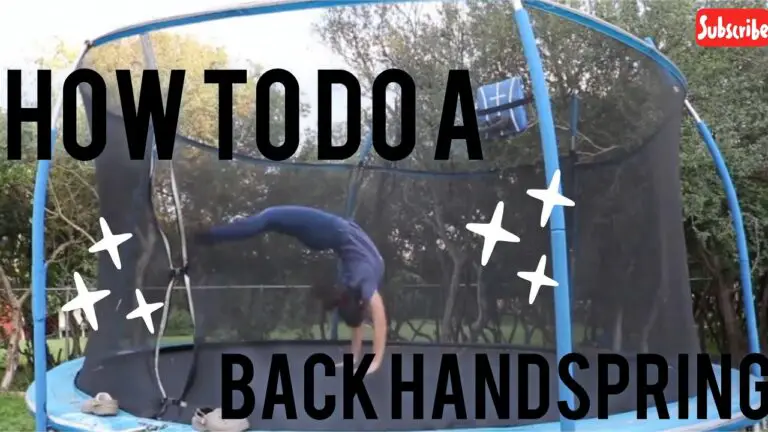One of the most popular backyard toys is the trampoline. However, this fun activity can also lead to serious injuries if proper safety measures are not followed. To avoid becoming a statistic, there are some things you can do.
First, make sure that the trampoline is in good condition and that all of the parts are securely fastened. If there are any tears or holes in the mat, it needs to be replaced before anyone uses it. Second, always have someone supervise when children are using the trampoline.
This way they can spot any unsafe behaviors and intervene before an injury occurs. Finally, teach children how to safely jump on the trampoline and land properly. These simple tips can help keep everyone safe while they enjoy this backyard favorite.
- Read the manufacturer’s safety instructions before using a trampoline
- Inspect the trampoline regularly for signs of wear and tear, and replace any damaged parts immediately
- Only allow one person to use the trampoline at a time, and never allow anyone to somersault or perform flips on the trampoline
- Use proper landing techniques when jumping on the trampoline, such as keeping your knees bent and your feet together
- Avoid landing on your stomach or head
- Disengage the Trampoline springs when not in use
How to Avoid Trampoline Injuries
Common Trampoline Knee Injuries
Trampoline knee injuries are becoming increasingly common, especially among young athletes. The most common trampoline knee injury is a torn anterior cruciate ligament (ACL). ACL tears can occur when the knees are extended too far while jumping on a trampoline.
Other common trampoline knee injuries include patellar tendonitis, meniscus tears, and chondromalacia patella (knee pain).
While many of these injuries can be treated with rest, ice, and physical therapy, some may require surgery. If you or your child experiences any knee pain after jumping on a trampoline, it’s important to see a doctor right away.
With proper treatment, most people make a full recovery from trampoline knee injuries.
Trampoline Injuries Per Year
According to the National Safety Council, there are an estimated 100,000 trampoline-related injuries in the United States each year. The majority of these injuries occur when multiple people are using the trampoline at the same time, and most of them are preventable with proper safety precautions.
The most common type of injury is a sprained ankle or wrist, followed by bruises and cuts.
More serious injuries can include broken bones, concussions, and spinal cord injuries. In rare cases, trampoline accidents have even resulted in death.
Most experts agree that the best way to prevent trampoline injuries is to limit the number of people using it at one time, make sure everyone is wearing proper safety gear, and supervise children closely when they’re using the equipment.
With a little bit of care and attention, everyone can enjoy this backyard staple safely.
Trampoline Injuries by Age
According to the U.S. Consumer Product Safety Commission, there were more than 98,000 trampoline-related injuries in 2015. The majority of these injuries (85%) occurred among children ages 0-14 years old.
Here’s a breakdown of trampoline injuries by age:
0-4 years: 4,070 injuries
5-9 years: 34, 390 injuries
10-14 years: 59,560 injuries
15-19 years: 1,880 injuries
20+ years: 2,410 injuries
As you can see, the vast majority of trampoline-related injuries occur in children under the age of 15.
This is likely due to the fact that young children are more likely to use trampolines unsupervised and without proper safety precautions.
Trampoline Neck Injuries
A trampoline neck injury is a serious and potentially life-threatening condition that can occur when someone uses a trampoline. This type of injury occurs when the user falls off the trampoline and lands on their head or neck, causing severe damage to the spinal cord or brain. Trampoline neck injuries can lead to paralysis or even death if not treated immediately.
There are several ways to prevent trampoline neck injuries from occurring. First, always use caution when using a trampoline and make sure that there is always someone else around to spot you in case you fall. Second, never attempt flips or other stunts on a trampoline unless you are experienced and have someone nearby to help you if something goes wrong.
Finally, always inspect your trampoline before use and make sure that it is in good condition with no loose parts or tears in the mat.
If you do suffer a trampoline neck injury, it is important to seek medical attention immediately. The sooner you are treated, the better your chances of recovery will be.
In some cases, surgery may be necessary to repair the damage caused by the fall. With prompt treatment and rehabilitation, many people who suffer from this type of injury are able to regain full function of their limbs and live normal lives once again.
Common Trampoline Leg Injuries
If you’re a fan of trampolining, then you know that there are many benefits to this fun activity. However, there are also some risks associated with it. One of the most common injuries that can occur while trampolining is a leg injury.
There are several different types of leg injuries that can occur while trampolining. The most common type is a sprained ankle. This happens when the ligaments in the ankle are stretched or torn.
Symptoms of a sprained ankle include pain, swelling, and bruising.
Another common type of leg injury is a stress fracture. This occurs when the bones in the leg are overworked and begin to crack or break.
Stress fractures typically happen in the shin or foot and can be extremely painful. symptoms include pain, swelling, and tenderness.
If you suffer from any kind of leg injury while trampolining, it’s important to seek medical attention right away.
These injuries can be serious and may require surgery or other treatment in order to heal properly.
Children’S Injuries on Trampolines
As the weather gets warmer and summertime approaches, many families are dusting off their trampolines in anticipation of hours of outdoor fun. However, before you let your kids loose on the trampoline, it’s important to be aware of the risks associated with this activity.
According to the Consumer Product Safety Commission (CPSC), there were more than 98,000 trampoline-related injuries in 2015.
And while most of these injuries are minor bumps and bruises, more serious injuries, including broken bones and concussions, do occur. In fact, CPSC reports that there were nearly 5,000 ER visits for head injuries related to trampolines in 2015.
So what can you do to help keep your kids safe on the trampoline?
First and foremost, make sure they always use proper safety gear including a well-fitting helmet when jumping. Secondly, never allow more than one jumper on the trampoline at a time – this will help reduce the risk of collision-related injuries. Finally, have an adult supervise any jumpers under the age of 6 – younger children are simply not developmentally ready for this type of high-impact activity and are more likely to be injured as a result.
By following these simple safety tips, you can help ensure that your family enjoys a fun and injury-free summer on the trampoline!
Trampoline Spinal Injuries
A trampoline can be a great way to have fun and get some exercise, but it’s important to be aware of the risks. Trampoline spinal injuries are not common, but they can be very serious.
There are a few things that can increase the risk of a spinal injury on a trampoline.
First, if the trampoline is not properly assembled or maintained, it can be more likely to collapse. Second, Somersaults and other flips should only be attempted by experienced jumpers. Third, multiple jumpers on the trampoline at the same time can increase the risk of collision and injury.
Finally, landing incorrectly can also lead to spinal injuries.
If you or someone you know does suffer a spinal injury while using a trampoline, it’s important to get medical help right away. Spinal cord injuries can have lifelong consequences, so prompt treatment is essential.
Trampoline Injury Icd-10
In the United States, there are approximately 100,000 trampoline-related injuries each year. The most common type of injury is a sprained ankle, followed by bruises and cuts. However, more serious injuries can occur, such as broken bones or concussions.
In some cases, trampoline accidents have even resulted in death.
Most trampoline injuries happen when multiple people are using the same trampoline at the same time. This can create a “domino effect” where one person’s jump causes another person to lose their balance and fall off the trampoline.
To avoid this, it’s important to make sure that only one person is jumping on the trampoline at a time.
If you or someone you know has been injured in a trampoline accident, it’s important to seek medical attention immediately. Depending on the severity of the injury, you may need to go to the hospital for x-rays or other tests.
If you have any questions about your injury or what to do next, be sure to ask your doctor or consult a personal injury lawyer.

Credit: www.healthymepa.com
What is the Most Common Injury on a Trampoline?
Most trampoline injuries happen when multiple people are using the trampoline at the same time. The most common injury is a sprained ankle, followed by a broken bone.
How Do Most Trampoline Injuries Occur?
Most trampoline injuries occur when multiple people are using the trampoline at the same time. This can cause one person to land on another, which can lead to serious injury. Additionally, landing on the edge or frame of the trampoline can also cause serious injury.
How Can You Be Safe on a Trampoline?
Most people think of trampolines as being exciting and fun. However, they can also be dangerous. Here are some tips to help you stay safe on a trampoline:
1. Inspect the trampoline before using it. Make sure that there are no rips or tears in the mat and that all of the springs are intact.
2. Only use the trampoline with adult supervision.
Do not allow children to play unsupervised on the trampoline.
3. Do not allow more than one person at a time on the trampoline. This will reduce the risk of collisions and injuries.
4 . Use appropriate footwear when jumping on the trampoline. Avoid shoes with hard soles as they can damage the matting.
instead, opt for socks or bare feet .
5Make sure everyone knows how to properly jump on a trampoline before allowing them to use it..
When jumping, always land in the center of the mat to distribute your weight evenly.. Keep your knees slightly bent to absorb any impact.
.
What Percentage of Trampoline Injuries Happen?
A recent study found that nearly 100,000 people are injured each year while using trampolines. Of those injuries, approximately 75 percent occur when multiple people are using the trampoline at the same time. The most common injuries are fractures and sprains, with head and neck injuries accounting for a significant portion of the more serious cases.
Conclusion
Most trampoline injuries can be avoided by following some simple safety tips. First, make sure the trampoline is in a safe area away from trees, buildings, and other obstacles. Second, always have someone supervise when children are using the trampoline.
Third, don’t allow more than one person on the trampoline at a time. Fourth, use proper jumping techniques and land in the center of the mat. Finally, inspect the trampoline regularly for tears or damage.
By following these simple tips, you can help avoid serious injuries while enjoying this fun activity.






